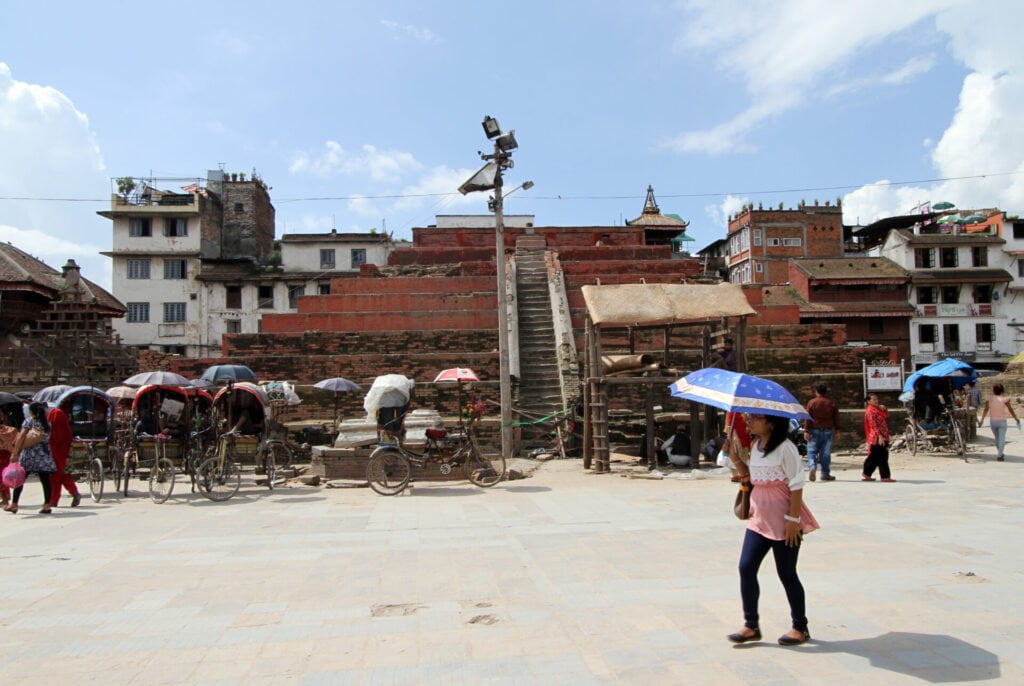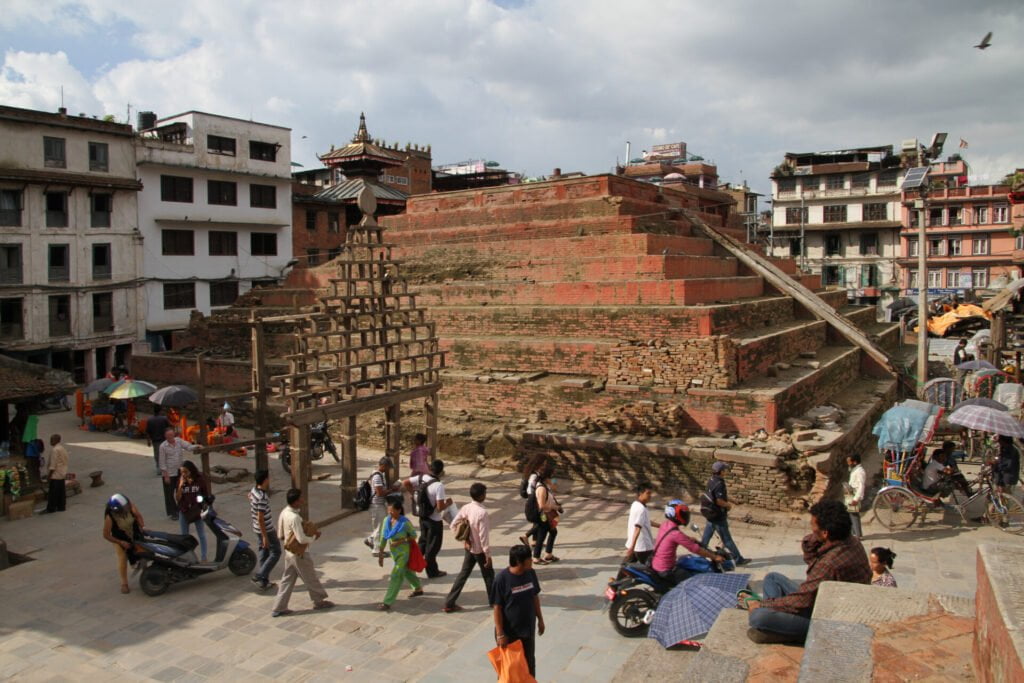Maju Dega Temple: A Symbol of Hope and Reconstruction in Durbar Square
The Maju Dega Temple, located in Kathmandu Durbar Square, Nepal, holds immense historic significance. This Hindu temple, dedicated to Lord Shiva, stands as a testament to the rich cultural and architectural heritage of Nepal.
Built in 1692 by Riddhi Lakshmi, the Queen mother of Bhupetendra Malla, the temple showcases exquisite craftsmanship and intricate carvings. Its construction during the reign of the Malla dynasty reflects the patronage of the arts and the importance of religious devotion during that period.
The Maju Dega Temple has not only been a place of worship but has also played a significant role in the socio-cultural fabric of Nepal. It has witnessed numerous religious ceremonies, festivals, and rituals throughout the centuries, attracting devotees and visitors from far and wide.
The temple’s location within Kathmandu Durbar Square adds to its historic significance. The square itself is a UNESCO World Heritage Site and is known for its numerous palaces, temples, and courtyards that date back to the medieval period. Maju Dega Temple stands tall among these architectural marvels, representing the fusion of Hindu and Nepalese architectural styles.
The Malla Dynasty and Maju Dega Temple
Built in 1692 by Queen Mother Riddhi Lakshmi, the temple is dedicated to Lord Shiva. It is considered one of the tallest and largest temples in the Durbar Square area. The temple’s nine-step brick base gives it an impressive height that dominates the skyline of Kathmandu Durbar Square.
Bhupetendra Malla, the infant King at the time, was the son of Queen Mother Riddhi Lakshmi. It was under her patronage and leadership that the Maju Dega temple was constructed. The temple bears the name “Maju Dega,” which translates to “Temple of Queen Mother.” This name commemorates the role of Riddhi Lakshmi in the temple’s creation.
Throughout its history, the Maju Dega temple has witnessed various cultural and historical events. During the Hippie era in the 1970s, the temple became known as the “Hippie Temple” due to its popularity among European and American Hippies. The temple’s top step provided a panoramic view of the surrounding area, attracting many social gatherings.
Unfortunately, the temple faced extensive damage during the devastating earthquake in 2015. Along with 11 other monuments in Durbar Square, Maju Dega suffered significant destruction. However, efforts have been made to restore and renovate this historic temple. The reconstruction project was inaugurated by Mayor Shakya in 2018, and the temple’s significance to the cultural heritage of Nepal is being recognized and preserved.

Maju Dega Temple: A Prominent Landmark
The Unique Architecture and Design of the Temple
One of the most striking features of the temple is its nine-step brick base, which adds to its aesthetic appeal. The temple stands tall and majestic, with intricate carvings that adorn every inch of its exterior. These carvings depict mythical creatures from Hindu mythology, showcasing the rich cultural heritage of Nepal.
The temple’s design is a testament to the skill and craftsmanship of the artisans of that era. The attention to detail and the precision with which the carvings have been executed are awe-inspiring. Each mythical creature is intricately carved, capturing their unique characteristics and bringing them to life.
The architecture of the Maju Dega temple is a blend of Hindu and Newari styles. The temple’s roof is adorned with multiple tiers and pagoda-like structures, adding to its grandeur. The vibrant colors used in the temple’s decorations further enhance its beauty.
Today, the temple continues to attract visitors from around the world. Its unique architecture and design, combined with the bustling atmosphere of Kathmandu, create a truly immersive cultural experience. As visitors admire the intricate carvings and soak in the spiritual atmosphere, a sense of tranquility and reverence fills the air.
Artifacts and Relics Honored in the Temple
One of the most prominent artifacts housed within the temple is an enormous shiva linga, which serves as the emblem of Lord Shiva. This sacred symbol holds great religious importance for the people of Nepal and is revered by devotees who visit the temple to seek blessings and offer prayers. The presence of such a significant relic within the temple further enhances its spiritual appeal and draws in both locals and tourists alike.
In addition to the shiva linga, the Maju Dega Temple boasts an impressive collection of intricately carved wooden doorways, columns, windows, and struts. Each of these elements showcases the exquisite craftsmanship of the Malla period and provides a glimpse into the artistic sensibilities of the time. The carvings depict various mythological figures, deities, and symbolic motifs, all of which add to the overall aesthetic beauty of the temple.
These artifacts and relics not only serve as a visual delight but also hold immense symbolic meaning for the people of Kathmandu. They represent a connection to their rich history and heritage, reminding them of the glorious past that shaped their identity. The preservation and restoration of these artifacts are of utmost importance to ensure that future generations can continue to appreciate and learn from their cultural legacy.

Preservation and Restoration Efforts
In the aftermath of the devastating earthquake that struck Nepal, the government has taken several steps to provide funding and support for the reconstruction efforts. One significant development is the appointment of Sushil Gyawali as the chief of the National Reconstruction Authority (NRA). This appointment marks an important milestone as it allows the agency to finally begin the process of rebuilding and disbursing aid to those affected by the earthquake.
Gyawali has made a promise of swift action to help the quake victims, who have received little aid beyond the initial government payout of $150 per household. This commitment comes as a ray of hope for the affected communities, as they have been eagerly waiting for assistance to rebuild their lives and homes.
Furthermore, the Nepali Parliament has recently approved two amendments to the constitution aimed at addressing the concerns of the residents of the Terai region. The agitation by the Madhesis, who have been demanding a greater representation and inclusion in the political processes, has been a significant challenge for the government. However, the approval of these amendments showcases the government’s efforts towards resolving the issues and ensuring that all citizens are treated fairly.
The government’s commitment to providing funding and support for reconstruction is crucial for the affected communities to recover and rebuild their lives. It is important to note that the process of reconstruction is not an easy task, considering the scale of devastation and the enormity of the resources required. However, with the appointment of Gyawali and the approval of the constitutional amendments, there is renewed hope that the government will take swift and effective action to address the needs of the quake victims.
In addition to government funding, it is also important to highlight the role of international aid and support in the reconstruction efforts. Various countries, organizations, and individuals have come forward to provide assistance to Nepal. This collaboration between the government and the international community is crucial for ensuring that the reconstruction efforts are carried out effectively and efficiently.

